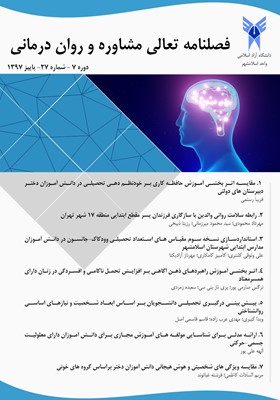ارائه مدلی برای شناسایی مولفه های آموزش مجازی برای دانش آموزان دارای معلولیت جسمی-حرکتی
محورهای موضوعی : فصلنامه تعالی مشاوره و روان درمانی
1 - کارشناس ارشد مدیریت آموزشی گرایش تحقیقات آموزشی دانشگاه آزاد اسلامی واحد رودهن
کلید واژه: مدل مفهومی, آموزش مجازی, معلولیت جسمی-حرکتی,
چکیده مقاله :
هدف: پژوهش ارائه مدلی برای شناسایی مؤلفههای آموزش مجازی برای دانش آموزان دارای معلولیت جسمی-حرکتی بود. روش پژوهش توصیفی-پیمایشی است. جامعه آماری پژوهش کلیه مدیران و مربیان مراکز آموزش استثنائی شهر تهران بودند. روش: نمونه گیری از طریق سرشماری انجام گرفت. ابزار اصلی پژوهش ۲ پرسشنامه محقق ساخته بود که دارای پایائی 79/0 با استفاده از ضریب آلفای کرونباخ بود. برای تحلیل داده ها از روش آمار توصیفی و آمار استنباطی (آزمون توزیع دوجمله ای، کای-دو) استفاده شد. از مجموع 120 مدیر و مربی که مورد پرسش قرار گرفتند 57 نفر به پرسشنامه پاسخ دادند که معادل 47.5% کل حجم جامعه آماری است. تنها 23% از این افراد در مورد حداقل یک درس تجربه آموزش مجازی با دانش آموزان خود داشتهاند. یافته ها: میزان اهمیت آموزش مجازی برای دانش آموزان دارای معلولیت های جسمی-حرکتی در حد زیاد و خیلی زیاد بود. آموزش مجازی در مؤلفههای تنظیم زمان آموزش، فراهم ساختن فرصت برابر آموزش برای کودکان دارای معلولیت جسمی-حرکتی، جلب مشارکت والدین، میزان دسترسی به آموزش، سهولت استفاده از امکانات آموزشی، کسب مهارتهای اجتماعی، برقراری ارتباط با دیگران، کاهش هزینه های آموزش برای والدین، کاهش هزینه های آموزش برای مدرسه، برقراری یادگیری مستمر، رفع نیازهای روانی دانش آموزان، افزایش اعتمادبه نفس دانش آموزان، در حد زیاد و خیلی زیاد مؤثر دانسته شد. ۱۱ مؤلفه جهت ارائه مدلی اجرائی مبتنی بر مؤلفههای آموزش مجازی برای دانش آموزان معلول جسمی-حرکتی در ایران شناسایی شدند و مدلی بر آن مبنا طراحی شد نتیجه گیری: با توجه به نتایج مشکلات موجود در سطح تمامی ۱۱ مؤلفه در حد متوسط نتیجه گیری شد. بنابراین آموزش مجازی می تواند بر مؤلفههای آموزش دانش آموزان دارای معلولیت جسمی-حرکتی تأثیر مثبت داشته باشد.
purpose: To provide a model for identifying the components of virtual education for students with physical-motor disabilities. The research method is descriptive-survey. Method: The statistical population of the study was all managers and coaches of the special education centers in Tehran. The sampling method was carried out through a census. The main research tool was a researcher-made questionnaire that had a reliability of 0.79 using Cronbach's alpha coefficient. For data analysis, descriptive statistics and inferential statistics (binomial distribution, Chi-2) were used. Findings: Out of 120 managers and instructors who were questioned, 57 responded to the questionnaire, which is equivalent to 47.5% of the total population. Only 23% of these people have had at least one virtual learning experience with their students. In terms of 60% of surveyed managers and educators, the importance of virtual education for students with physical-motor disabilities was high and very high. Vocational education in the components of time setting training, providing equal opportunity education for children with physical-motor disabilities, parental involvement, access to education, ease of use of educational facilities, acquisition of social skills, communication with others, reduction of training costs For parents, reducing the costs of school education, continuing learning, meeting the students' psychological needs, and increasing the confidence of students was highly and very effective. 11 components were identified to provide an executive model based on the components of virtual education for students with physical-motor disabilities in Iran and a model was designed based on it. Discussion: According to the results of the problems in the level of all 11 components, the average score was reached. Therefore, virtual education can have a positive effect on the educational components of students with physical-motor disabilities.
_||_

